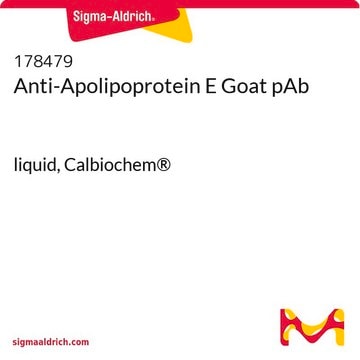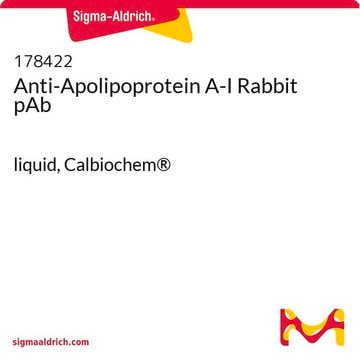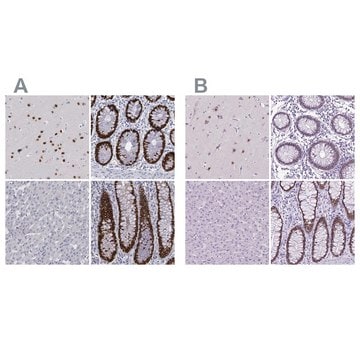178467
Anti-Apolipoprotein B Goat pAb
liquid, Calbiochem®
Sign Into View Organizational & Contract Pricing
All Photos(1)
About This Item
UNSPSC Code:
12352203
NACRES:
NA.43
Recommended Products
biological source
goat
Quality Level
antibody form
diluted serum
antibody product type
primary antibodies
clone
polyclonal
form
liquid
contains
≤0.1% sodium azide as preservative
species reactivity
human
manufacturer/tradename
Calbiochem®
storage condition
OK to freeze
avoid repeated freeze/thaw cycles
isotype
IgG
shipped in
wet ice
storage temp.
−20°C
target post-translational modification
unmodified
General description
Anti-Apolipoprotein B, goat polyclonal, recognizes human apolipoprotein B. It is validated for Western blotting, immunoelectrophoresis, and immunoprecipitation.
Goat polyclonal antibody supplied as diluted serum that has been defibrinated, delipidized, and adsorbed by solid phase chromatography. Recognizes apolipoprotein B.
Recognizes apolipoprotein B.Antibody Target Gene Symbol: APOB Target Synonym: Aa1064, Ac1-060, AI315052, ApoB-100, APOB-29, ApoB-48, APOLIPOPROTEIN B, APOLIPOPROTEIN B100, FLDB, LDLCQ4, MGC176318 Entrez Gene Name: apolipoprotein B (including Ag(x) antigen) Hu Entrez ID: 338 (Related Antibodies: 178446, 178444) Mu Entrez ID: 238055 Rat Entrez ID: 54225
Immunogen
Human
purified human, apolipoprotein B
Application
Immunoblotting (see application references)
Immunoelectrophoresis (see comments)
Immunoprecipitation (Becker titer, ≥21 mg/ml)
Immunoelectrophoresis (see comments)
Immunoprecipitation (Becker titer, ≥21 mg/ml)
Packaging
Please refer to vial label for lot-specific concentration.
Warning
Toxicity: Standard Handling (A)
Physical form
Serum diluted in 500 mM NaCl, 50 mM Tris-HCl, pH 7.5.
Reconstitution
Following initial thaw, aliquot and freeze (-20°C).
Other Notes
Monospecific as determined by immunoelectrophoresis (IEP) against 2X pooled human serum and neat pooled human plasma. Variables associated with assay conditions will dictate the proper working dilution.
Legal Information
CALBIOCHEM is a registered trademark of Merck KGaA, Darmstadt, Germany
Not finding the right product?
Try our Product Selector Tool.
Storage Class Code
10 - Combustible liquids
WGK
WGK 1
Flash Point(F)
Not applicable
Flash Point(C)
Not applicable
Certificates of Analysis (COA)
Search for Certificates of Analysis (COA) by entering the products Lot/Batch Number. Lot and Batch Numbers can be found on a product’s label following the words ‘Lot’ or ‘Batch’.
Already Own This Product?
Find documentation for the products that you have recently purchased in the Document Library.
David Melville et al.
Molecular biology of the cell, 30(3), 387-399 (2018-11-30)
COPII-coated vesicles are the primary mediators of ER-to-Golgi trafficking. Sar1, one of the five core COPII components, is a highly conserved small GTPase, which, upon GTP binding, recruits the other COPII proteins to the ER membrane. It has been hypothesized
David B Melville et al.
The Journal of biological chemistry, 295(25), 8401-8412 (2020-05-03)
Vesicles that are coated by coat protein complex II (COPII) are the primary mediators of vesicular traffic from the endoplasmic reticulum to the Golgi apparatus. Secretion-associated Ras-related GTPase 1 (SAR1) is a small GTPase that is part of COPII and
Enrico D Perini et al.
Traffic (Copenhagen, Denmark), 15(12), 1366-1389 (2014-10-01)
Early endosomes are organized in a network of vesicles shaped by cycles of fusion, fission, and conversion to late endosomes. In yeast, endosome fusion and conversion are regulated, among others, by CORVET, a hexameric protein complex. In the mammalian endocytic
Yuehui Wang et al.
PloS one, 4(12), e8442-e8442 (2009-12-31)
A small fraction of dietary protein survives enzymatic degradation and is absorbed in potentially antigenic form. This can trigger inflammatory responses in patients with celiac disease or food allergies, but typically induces systemic immunological tolerance (oral tolerance). At present it
Tanja Kosenko et al.
The Journal of biological chemistry, 288(12), 8279-8288 (2013-02-13)
Proprotein convertase subtilisin/kexin type-9 (PCSK9) is a secreted protein that binds to the epidermal growth factor-like-A domain of the low density lipoprotein receptor (LDLR) and mediates LDLR degradation in liver. Gain-of-function mutations in PCSK9 are associated with autosomal dominant hypercholesterolemia
Our team of scientists has experience in all areas of research including Life Science, Material Science, Chemical Synthesis, Chromatography, Analytical and many others.
Contact Technical Service








